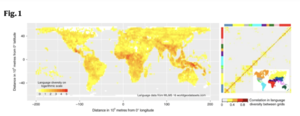Language typology approach to ecolinguistics
Language typology[edit | edit source]
is the study of language on a cross-linguistic level aiming to understanding the commonalities and variation across the languages of the world. Typology does not study any one individual language but rather various sets of languages to help understand the diversity and complexity of the world's languages.
Typological approaches to ecolinguistics[edit | edit source]
While typology may not be the first approach one thinks of to use with ecolinguistics, one may be surprised to learn about the various ways typological approaches can be applied to understand the environment and language for the objectives of ecolinguistics.
Typology can be used to examine the relationship between language typology and language endangerment. Since many endangered languages are spoken by small communities, typology may give us insights about where multilingualism is maintained and factors that influence the maintenance of multilingual ecologies. It is known that the smaller the communities, the more multilingual they tend to be. There is also evidence that the smaller speech communities are, the more complex their structures tend to be as well as the contrary, the larger the speech community, the more the language simplifies its structures. More on these topics can be read about on the page for the ERC funded GramAdapt[1] project at the University of Helsinki led by Kaius Sinnemäki. All this is mentioned to explain that typology can tell us a lot about languages that can give important insights that connect with the environment.

Typological studies have been known to also trace the connection between linguistic diversity and biodiversity by scholars [3][4]. There has been correlation between the climate and linguistic diversity as well as biodiversity. Similar studies could be conducted to understand environmental phenomena cross-linguistically.
These are merely a few examples of how typology can be employed to understand the relationship between language and environment to make up ecolinguistics. Typology is a useful approach for comparing and contrasting high numbers of languages and their ecological knowledge to help identify patterns and trends cross-linguistically.
- ↑ https://www.helsinki.fi/en/researchgroups/linguistic-adaptation/about
- ↑ https://www.nature.com/articles/s41467-019-09842-2
- ↑ Nettle, D. Explaining global patterns of language diversity. J. Anthropol. Archaeol. 17, 354–374 (1998).
- ↑ https://www.pnas.org/doi/10.1073/pnas.1117511109